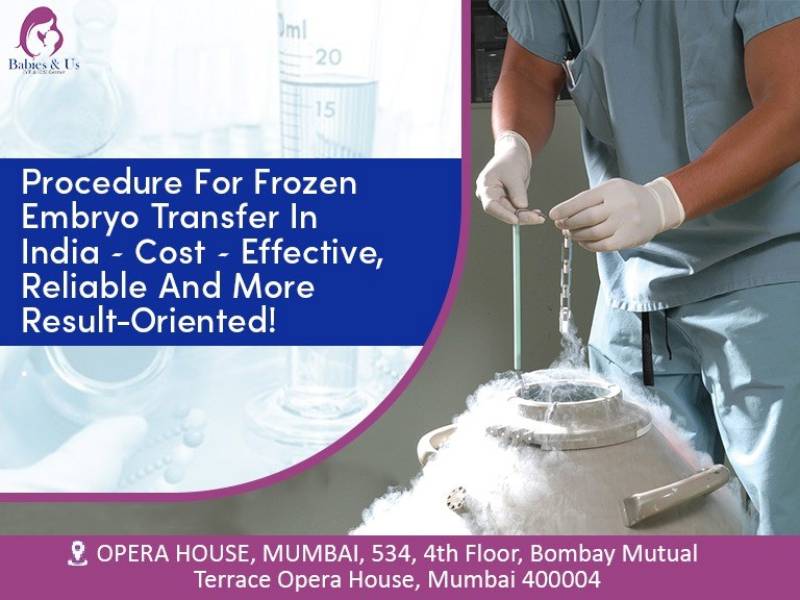Business
Procedure for frozen embryo transfer in India – Cost –effective, Reliable and more Result-oriented!

Individuals or couples seeking to proceed with their IVF cycle through a frozen embryo transfer procedure must plan their procedure correctly. The frozen embryo, or a cryopreserved embryo, is collected during the previous egg retrieval procedure and preserved for its use in the future. Therefore, a frozen embryo transfer procedure is one of the most critical procedures in the IVF cycle that needs proper execution.
Dr. Hrishikesh Pai, founder-director of Babies and Us, a leading IVF Centre in Mumbai, suggests, ’I recommend a frozen embryo transfer procedure to gestational parents who require in-depth clinical evaluation on account of personal factors and wish to ensure a successful IVF cycle. Dr Hrishikesh Pai is the pioneer of IVF technology in India with nearly three decades of experience in ART.
The frozen embryo transfer procedure is done in two ways, viz. FET with Hormonal Support and FET Natural Cycle. In both the cycles, the day of freezing the embryo and the timing of the frozen embryo transfer are the two most important factors that ensure a successful FET transfer.
In the case of a FET with a Hormonal Support procedure, the gestational patient has to take hormonal support to shut down the reproductive cycle at the end of her previous menstrual cycle, followed by two weeks of estrogen supplementation and progesterone supplementation.
During this period, she will have to undergo a pelvic scan and certain tests to ascertain the uterine health and lining. The schedule of the frozen embryo transfer will depend upon the day and stage of embryo cryopreservation and the day of commencement of progesterone supplementation.
On the other hand, Frozen Embryo Transfer Natural cycle is scheduled as per the natural ovulation cycle of the patient. In this procedure, the most crucial factor is the timing of the embryo transfer, as it should take place within pre-determined days after ovulation.
Dr Pai elaborates on the multiple reasons for preferring a frozen embryo transfer. First, it is possible to preserve the available embryos from an ongoing IVF cycle for future use. Their future requirement could arise in case of failed IVF cycles, pregnancy loss or the decision to go ahead with a child after certain years. In such cases, frozen embryo transfer does greatly help to smooth proceed with the IVF procedure. Also, the patient may experience worsening ovarian hyperstimulation syndrome, which can cause complications in the IVF cycle leading to its failure.
Other reasons include the period involved in genetic testing of embryos to rule out chromosomal abnormalities or gestational patients with polyps or a thin endometrium issue that could lead to failure of the IVF cycle. Hence it is advisable to freeze the embryo and opt for frozen embryo transfer.
Also, the success rates of a frozen embryo transfer are more than 60% per transfer and hence are considered quite encouraging. The children born through this procedure are healthier and are born near term, which is equally promising.
However, it is essential to consider the other influencing factors such as the age of the gestational patient, quality of frozen embryos, day of freezing, endometrial thickness and so on for its success.
Undoubtedly, frozen embryo transfer has emerged as one of the most preferred IVF options for couples who have opted to freeze their embryos during their most fertile period. With the added convenience of ensuring suitable medical conditions, especially uterine health and genetic screening, if required, the success rate of the IVF cycle following a frozen embryo transfer greatly increases.
-

 Business3 weeks ago
Business3 weeks agoPrakash and Kamal Hinduja: Driving Social and Environmental Change
-
Education4 weeks ago
Fred DuVal: University Leadership as a Critical Resource for Climate Change Research and Life-Saving Solutions
-

 Cryptocurrency3 weeks ago
Cryptocurrency3 weeks agoDesigned For The Masses: How Akasha (AK1111) Is Unlocking Crypto For The Next Billion Users
-

 Health3 weeks ago
Health3 weeks agoThe Hinduja Brothers Commitment to Global Health: Empowering Communities Across Borders
-

 Cryptocurrency4 weeks ago
Cryptocurrency4 weeks agoNexaglobal & Future World Token (FWT): Could This Be the Next Big Crypto Investment of 2025?
-

 Startup2 weeks ago
Startup2 weeks agoCost-Saving Strategies Every Small Business Owner Should Know to Boost Efficiency
-

 Startup3 weeks ago
Startup3 weeks agoMatthew Denegre on the Art of Deal Sourcing: Finding the Right Investment Opportunities
-

 Health2 weeks ago
Health2 weeks agoSt. John’s Community Health Examines Innovations in Pharmacy Access











